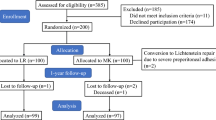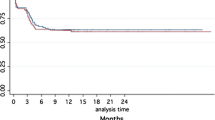Abstract
Purpose
The aim of this study was to compare the transinguinal preperitoneal technique (TIPP) using a memory ring patch versus the Lichtenstein technique in relation to acute and chronic pain, post-operative complications and recurrence rates.
Methods
During an 18-month period, all adult patients that needed treatment for a unilateral inguinal or femoral hernia were treated by the TIPP repair using the Polysoft™ mesh. This group was retrospectively compared with a historical cohort of patients treated by the Lichtenstein technique. Our policy concerning type of anaesthesia, post-operative pain management and visual analogue scale measurements did not change over the study period. For post-operative pain evaluation, the visual analogue scale was used (0–10) and scores were measured after 6 h, 24 h, 1 week, 1 month, 1 year and yearly thereafter. Recurrence rates were evaluated at time of clinical examinations.
Results
In total, 142 patients have been analysed with the TIPP technique (group I) versus 136 patients operated in the previous 2 years with a Lichtenstein repair (group II). In group I, 112 patients (78.9%) received a medium size patch of 14 × 7.5 cm and 30 patients (21.1%) had a large patch (16 × 9 cm). The mean operative time for a TIPP procedure was statistically shorter than for a Lichtenstein repair, 33 versus 44 min, respectively (p = 0.04). After 24 h, 1 week and 1 month post-surgery, there was significantly less post-operative pain observed in the TIPP group than in the Lichtenstein group. In total, four recurrences were observed in the TIPP group (2.8%), of which one laterally and three medially. In group II, seven recurrences were observed in total (5.1%), of which five were detected within 2 years of follow-up (3.7%).
Conclusion
For surgeons performing the Lichtenstein repair but looking for modifications concerning pain relief and a quicker procedure, the TIPP approach is a feasible alternative that seems to be associated with less post-operative pain.
Similar content being viewed by others
References
Aasvang EK, Bay-Nielsen M, Kehlet H (2006) Pain and functional impairment 6 years after inguinal herniorrhaphy. Hernia 10:316–321
Bay-Nielsen M, Nilsson E, Nordin P, Kehlet H (2004) Chronic pain after open mesh and sutured repair of indirect inguinal hernia in young males. Br J Surg 91:1372–1376
Callesen T, Bech K, Kehlet H (1999) Prospective study of chronic pain after groin hernia repair. Br J Surg 86:1528–1531
Champault G, Bernard C, Rizk N, Polliand C (2007) Inguinal hernia repair: the choice of prosthesis outweighs that of technique. Hernia 11:125–128
Franneby U, Sandblom G, Nordin P, Nyren O, Gunnarsson U (2006) Risk factors for long-term pain after hernia surgery. Ann Surg 244:212–219
Stoppa R, Petit J, Abourachid H et al (1973) Original procedure of groin hernia repair: interposition without fixation of Dacron tulle prosthesis by subperitoneal median approach. Chirurgie 99:119–123
Rives J, Lardennois B, Flament JB, Convers G (1973) The Dacron mesh sheet, treatment of choice of inguinal hernias in adults. Apropos of 183 cases. Chirurgie 99:564–575
Gilbert AI (1992) Sutureless repair of inguinal hernia. Am J Surg 163:331–335
Kugel RD (1999) Minimally invasive, nonlaparoscopic, preperitoneal, and sutureless, inguinal herniorrhaphy. Am J Surg 178:298–302
Veenendaal LM, de Borst GJ, Davids PH, Clevers GJ (2004) Preperitoneal gridiron hernia repair for inguinal hernia: single-center experience with 2 years of follow-up. Hernia 8:350–353
Pelissier EP (2006) Inguinal hernia: preperitoneal placement of a memory-ring patch by anterior approach. Preliminary experience. Hernia 10:248–252
Berrevoet F, Sommeling C, De Gendt S et al (2009) The preperitoneal memory-ring patch for inguinal hernia: a prospective multicentric feasibility study. Hernia 13:243–249
Muldoon RL, Marchant K, Johnson DD et al (2004) Lichtenstein vs anterior preperitoneal prosthetic mesh placement in open inguinal hernia repair: a prospective, randomized trial. Hernia 8:98–103
Kehlet H, Bay Nielsen M (2005) Anaesthetic practice for groin hernia repair—a nation-wide study in Denmark 1998–2003. Acta Anaesthesiol Scand 49(2):143–146
Kehlet H, Dahl JB (2003) Spinal anaesthesia for inguinal hernia repair? Acta Anaesthesiol Scand 47(1):1–2
Nienhuijs S, Staal E, Keemers-Gels M et al (2007) Pain after open preperitoneal repair versus Lichtenstein repair: a randomized trial. World J Surg 31(9):1751–1757 discussion 1758–9
Author information
Authors and Affiliations
Corresponding author
Rights and permissions
About this article
Cite this article
Berrevoet, F., Maes, L., Reyntjens, K. et al. Transinguinal preperitoneal memory ring patch versus Lichtenstein repair for unilateral inguinal hernias. Langenbecks Arch Surg 395, 557–562 (2010). https://doi.org/10.1007/s00423-009-0544-2
Received:
Accepted:
Published:
Issue Date:
DOI: https://doi.org/10.1007/s00423-009-0544-2




